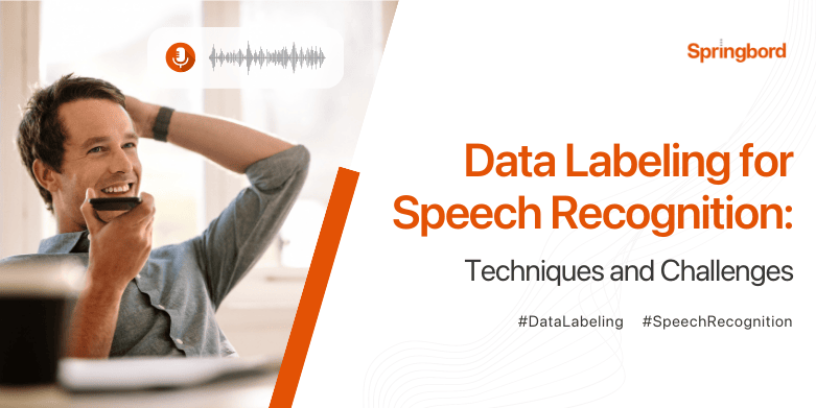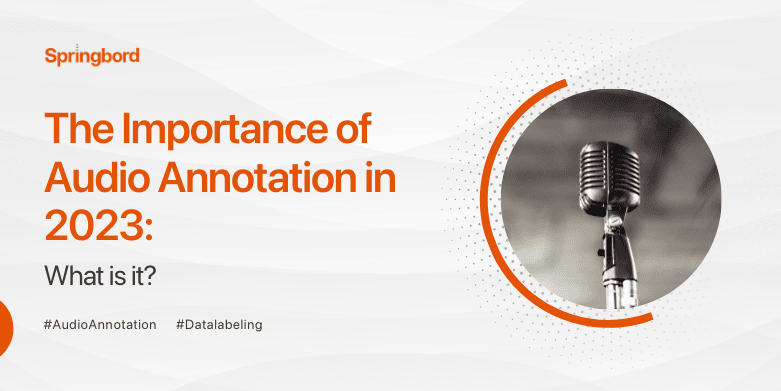 Read time 8 min
Read time 8 minData labeling for speech recognition plays a pivotal role in training accurate and reliable speech recognition systems.
Data labeling entails analyzing and categorizing speech data for machine learning algorithms to recognize and transcribe spoken words effectively.
In light of the growing demand for speech-enabled technologies, such as virtual assistants and voice-controlled devices, accurate data labeling is crucial.
This article will explore the techniques and challenges associated with data labeling for speech recognition.
Techniques for Data Labeling in Speech Recognition
Data labeling is a crucial step in training speech recognition systems, as it involves annotating the input audio data with corresponding text transcriptions. Precise and trustworthy data labeling is required for efficient automated speech recognition (ASR) models.
However, data labeling can be a tedious process that takes the careful evaluation of several methods to guarantee the accuracy and efficiency of the resulting labeled dataset.
1. Manual Annotation:
Traditionally, data labeling has been done using “manual annotation,” in which humans listen to audio recordings and transcribe them into written text. Humans’ natural language comprehension and contextualization skills make this approach particularly reliable.
It supports in-depth labeling and performs well in challenging speech settings.
Manual annotation, on the other hand, is a tedious and laborious procedure that calls for expert annotators who are fluent in the target language and knowledgeable about the topic. The cost can quickly add up when dealing with massive amounts of data.
2. Crowd-Sourcing:
Data labeling jobs can also be outsourced to a crowd of people using crowd-sourcing platforms, which offers an alternative to manual annotation. Companies can save time and money by using these systems to divide the annotation task across several annotators.
Crowd-sourcing shines most in the context of massive undertakings with limited time frames. Since workers may have varied experience levels, it might require more work to ensure the quality and uniformity of annotations.
Accurate labeling requires appropriate quality control procedures like multiple annotations per sample and consensus-based voting.
3. Semi-Supervised Learning:
Third, semi-supervised learning trains speech recognition models by combining labeled and unlabeled input. In this method, just a subset of the data is labeled by hand, while the remainder is left unlabeled.
The model takes what it learned from the labeled data and extrapolates it to the unlabeled data to make predictions. Human annotators check over the predictions and fix any mistakes they find.
This iterative process enhances the performance of the model, and the amount of effort needed to annotate data is decreased. Semi-supervised learning excels when there is a shortage or high cost of labeled data.
4. Active Learning:
An active learning data labeling method uses ML models to determine which data points should be annotated. The models are first trained on a relatively small labeled dataset, and then they actively ask the annotators to clarify the labels of any unclear examples.
Active learning improves the effectiveness of labeling by maximizing the impact of each annotation by directing efforts toward difficult situations. When time and resources for annotation are scarce, this method shines because it enables the development of accurate models with fewer labeled samples.
5. Transfer Learning:
Transfer learning can make data labeling in voice recognition more efficient, using previously labeled datasets or pre-trained models from a similar domain. Transfer learning uses previously acquired information and established patterns to speed the learning process and get better results.
Using this method, you can train a speech recognition system with far less labeled data. One can attain competitive performance with minimal labeling work by fine-tuning pre-trained models on a smaller labeled dataset specific to the target domain.
Challenges in Data Labeling for Speech Recognition
Data labeling for speech recognition poses various challenges that impact the accuracy and reliability of the trained models.
These challenges arise from the need for standardized labeling guidelines, accents and dialects, background noise, and audio quality. To create reliable speech recognition systems, certain obstacles must be overcome.
#1. Lack of standardized labeling guidelines:
No universally accepted standards for labeling data used in voice recognition presents a considerable barrier. Inconsistencies in the labeled dataset may result from multiple annotators’ interpretations and labelings of the same audio data without explicit criteria.
Reduced precision and the inability to reliably compare results from different studies or datasets also result in consistency. To address this difficulty, we need to develop specific criteria that specify categorizing and naming different varieties of speech.
#2. Accents, dialects, and speech variations:
Second, speech recognition algorithms are challenged by the enormous variety of accents, dialects, and speech variants they encounter in real-world settings. The inclusion of different linguistic features complicates data labeling.
Transcribers may need to correct while classifying speech with an unusual accent or dialect. Differences in pronunciation, speech pace, and intonation patterns make categorizing sounds difficult.
To overcome this difficulty, there must be defined rules for dealing with accent and dialect variances and specialized training and knowledge for annotators.
#3. Background noise and audio quality:
Third, the existence of background noise and fluctuations in audio quality present a substantial problem when labeling data for speech recognition. The quality of an audio recording might be diminished by ambient noise, traffic, or microphone artifacts.
This makes it hard for annotators to separate the voice from the background noise when transcribing it. Inaccurate labeling due to subpar audio can hinder the development of a reliable speech recognition system.
Noise reduction, audio improvement, and careful sample selection are examples of the pre-processing approaches that mitigate this difficulty before labeling begins.
#4. Scaling and efficiency:
As the need for voice recognition systems grows, scalability and efficiency become significant obstacles to overcome when labeling data. For large datasets, manual labeling procedures can tax time and resources.
This problem can be alleviated by using automated or semi-automatic labeling techniques. However, keeping the quality of the labeled dataset high requires verifying the precision and consistency of automated or semi-automatic labeling methods.
#5. Subjectivity and inter-annotator agreement:
Speech recognition data labeling requires subjective judgments because various annotators may interpret the same speech sample differently. Even with uniform standards, these subjective factors can cause labeling discrepancies.
To evaluate the consistency and dependability of the labeled data, it is necessary to construct measures for inter-annotator agreement. Improve the labeling quality and reduce disparities between annotators using inter-rater reliability measurements and iterative feedback loops.
Quality Control in Data Labeling for Speech Recognition
Since the labeled dataset’s accuracy and reliability directly impact the performance of trained speech recognition models, quality control plays a crucial role in data labeling for voice recognition. Errors, inconsistencies, and biases in the labeling process can be reduced using rigorous quality control procedures.
1. Clear labeling guidelines:
First, criteria must be established to ensure that data labels are always correct and consistent. The standards should address various issues, such as handling overlapping or unclear speech, accents and dialects, punctuation, and formatting.
The consistency of annotated data is greatly improved by having well-defined criteria annotators can follow.
2. Training and calibration of annotators:
The quality of labels relies on the expertise of the annotators who created them; thus, it’s important to invest time and effort into their training and calibration.
Guidelines for labeling, basic ideas of speech recognition, and typical obstacles should all be covered in detail during annotators’ training. Annotators’ understanding and consistency can be aligned through regular calibration sessions, comparing and debating their labeling selections.
3. Inter-rater reliability and agreement:
The degree to which various annotators agree on classifying the same data is measured by inter-rater reliability. Labeling quality can be evaluated by calculating inter-rater reliability metrics like Cohen’s or Fleiss’ kappa.
A lower score indicates a need for additional explanation or instruction, whereas a higher score indicates greater consistency. Tracking inter-rater reliability is important to spot problems early to improve labeling quality.
4. Iterative feedback loops:
Having annotators and project managers set up feedback loops helps improve the quality assurance procedure. They might provide feedback on their labeling judgments to help annotators become more accurate and efficient.
Collaboration is fostered through regular communication and feedback sessions when annotators can address concerns, clarify guidelines, and debate difficult cases, all contributing to more consistent labeling.
5. Quality assurance checks:
Implementing quality assurance checks is a crucial part of the data labeling procedure, which is why it is the fifth stage. To perform these tests, a small sample of labeled data is examined for mistakes, discrepancies, or biases.
Thorough checks are performed to evaluate the accuracy of labeling and ensure adherence to requirements by quality assurance teams or project managers. When problems or anomalies are discovered during these tests, they are fixed so the labeled dataset can remain high quality.
Future Directions and Innovations in Data Labeling for Speech Recognition
Data labeling for speech recognition is an evolving field that continues to witness advancements and innovations. Several promising future paths and breakthroughs exist in data labeling for speech recognition. Data labeling innovations, future automation, and machine learning developments fall into this category.
A. Active Learning:
First, there is active learning, which uses methods that select the most useful samples for annotation to increase the speed with which data can be labeled.
These strategies use machine learning algorithms to pinpoint specific pieces of information that can be used to lower prediction uncertainty. Active learning can drastically cut labeling time while keeping or even boosting model performance by prioritizing labeling these samples.
B. Data Augmentation:
Second, data augmentation methods create simulated data by reshaping preexisting annotated data. Changes in pitch, rate, volume, or speaker characteristics are all examples of augmentations that can be applied to speech recognition.
Speech recognition models benefit from data augmentation because it expands and diversifies the labeled dataset, making it more generalizable and stable.
C. Multimodal Labeling:
Thirdly, multimodal labeling is required because of the development of multimodal speech recognition systems that integrate audio with additional modalities like text or video.
Speech content and related textual transcriptions or visual clues are annotated in a multimodal labeling process. This paves the way for the training of multi-modal speech recognition models, which are more accurate and complete.
Potential advancements in automation and machine learning for data labeling:
Automatic Speech Recognition (ASR)-based Labeling:
First, using Automatic voice Recognition (ASR) systems, the initial labeling of voice data can be automated. Automatic transcription of the speech data is possible using ASR models that have already been trained, yielding rough labels that human annotators can modify.
The time and effort spent manually labeling data are cut down significantly, and the entire process is sped up using this semi-automatic method.
Active Error Correction:
Machine learning algorithms can actively repair faults by identifying and fixing mistakes in the labeling process. These algorithms can reduce the workload of human annotators while simultaneously increasing labeling accuracy by analyzing trends in the labeled data and using contextual information.
Transfer Learning and Pre-training:
Pre-training and transfer learning can speed up labeling for new tasks or domains using models learned on large-scale speech datasets.
Pre-trained models can be used to speed up and improve the efficiency of labeling new datasets by providing starting labels or acting as feature extractors.
To Sum Up
Due to the increasing significance of precise data labeling in speech recognition systems, businesses must partner with a dependable and seasoned provider. Here, Springbord Data enters into play.
As the foremost authority in data labeling, Springbord Data provides specialized services to meet each client’s needs. With more than two decades of experience, we have comprehensively understood the difficulties and methods involved in data labeling for speech recognition.
By partnering with Springbord Data Labeling Services, your organization will save valuable time and resources and ensure its speech recognition systems operate efficiently.







